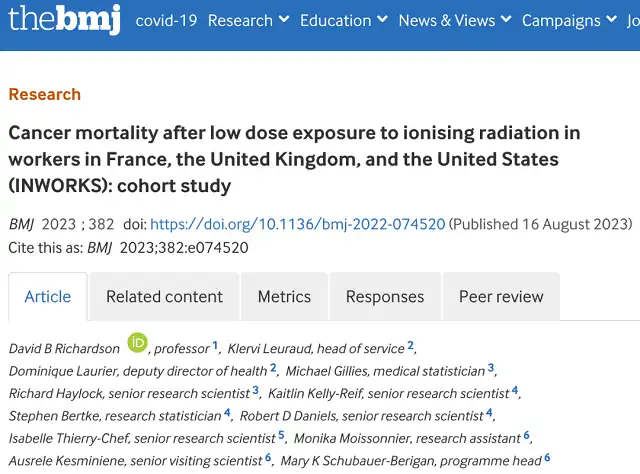New Study Reveals Higher Cancer Risk from Low-Dose Radiation
- Early Biomarker for Multiple Sclerosis Development Identified Years in Advance
- Aspirin Found Ineffective in Improving Recurrence Risk or Survival Rate of Breast Cancer Patients
- Child Products from Aliexpess and Temu Contain Carcinogens 3026x Over Limit
- Daiichi Sankyo/AstraZeneca’s Enhertu Shows Positive Results in Phase III DESTINY-Breast06 Clinical Trial
- Mn007 Molecules Offer Potential for Combating Streptococcus pyogenes Infection
- Popular Indian Spices Banned in Hong Kong Over Carcinogen Concerns
New Study Reveals Higher Cancer Risk from Low-Dose Radiation
- AstraZeneca Admits for the First Time that its COVID Vaccine Has Blood Clot Side Effects
- Was COVID virus leaked from the Chinese WIV lab?
- HIV Cure Research: New Study Links Viral DNA Levels to Spontaneous Control
- FDA has mandated a top-level black box warning for all marketed CAR-T therapies
- Can people with high blood pressure eat peanuts?
- What is the difference between dopamine and dobutamine?
- How long can the patient live after heart stent surgery?
New Study Reveals Higher Cancer Risk from Low-Dose Radiation.
BMJ: Low-Dose Radiation Carcinogenicity Exceeds Expectations! Data from over 300,000 nuclear industry workers show that for every 1 Gy increase in cumulative radiation exposure, the risk of cancer-related death increases by 52%.
Ionizing radiation, such as nuclear radiation, is widely recognized as a carcinogen.
Unlike other carcinogens that can be eliminated from the environment once identified, ionizing radiation is not only difficult to eliminate but has also been steadily increasing over the past few decades.
Previous research based on survivors of the atomic bombings in Hiroshima and Nagasaki confirmed the relationship between acute high-dose nuclear radiation and cancer. However, the hazards of chronic low-dose radiation (environmental, medical, or workplace exposure) have lacked reliable research data. Nevertheless, it was generally believed that the carcinogenic risk of low-dose radiation was low.
Recently, a research team led by David B. Richardson at the University of California, Irvine, studied data spanning decades from the International Nuclear Workers Study (INWORKS) cohort, which included over 300,000 individuals. Their findings confirm that the hazards of chronic low-dose radiation far exceed expectations.
As cumulative radiation exposure increases, the risk of death from solid tumors gradually rises. Specifically, for every 1 Gy increase in cumulative exposure, the risk of death from solid tumors increases by 52%. Within the low-dose range (0-100 mGy), the risk even doubles, with a 112% increase per Gy.
This groundbreaking research has been published in the prestigious medical journal “The British Medical Journal” (BMJ).

Screenshot of the paper’s cover page
The study included a total of 309,932 nuclear industry workers from France, the UK, and the US, including 40,445 women, with a total follow-up period of 10.7 million person-years.
By the end of the follow-up period, 103,553 individuals had died, with 31,009 of them dying from cancer and 28,089 from solid tumors. Overall, for every 1 Gy increase in radiation exposure, the risk of cancer-related death increased by 53%, and the risk of solid tumor-related death increased by 52%. When excluding the impact of smoking-related lung cancer, the risk of solid tumor-related death increased by 46% for every 1 Gy increase in radiation exposure.

Overall Impact
To assess risk trends within lower cumulative dose ranges, the Richardson team estimated the relationship between cumulative dose and solid cancer mortality.
Specifically, within the cumulative dose range of 0-400 mGy, there was a 63% increase in the risk of solid tumor-related death per Gy. Within the 0-200 mGy cumulative dose range, the risk increased by 97% per Gy, and within the 0-100 mGy range, the risk increased by 112% per Gy. Within the 0-50 mGy range, the risk increased by 138% (not statistically significant), and within the 0-20 mGy range, the risk increased by 130% (not statistically significant).

Dose-Response Relationship
In summary, this data indicates that chronic low-dose radiation significantly increases the risk of solid tumor-related death. This provides important evidence for the establishment of occupational radiation exposure standards.
So, how should the general public interpret this research data?
First, it’s undeniable that the risks of low-dose radiation are greater than expected.
This means that radiation exposure in medical, occupational, or environmental settings, even at low doses, may potentially lead to cancer.
Therefore, optimizing radiation exposure in these settings is necessary to reduce the risk of cancer.
Second, there’s no need for excessive concern.
Professor Paul Pharoah, an epidemiologist at the Cedars-Sinai Medical Center, has analyzed this data in detail.
From the perspective of common medical examinations, a chest X-ray is equivalent to about 0.1 mGy, a mammogram is about 0.2 mGy, and a chest CT scan is about 6 mGy.
Based on this study’s data, a person receiving five chest CT scans has a relative 2.5% increase in the risk of solid cancer, while someone undergoing 20 chest X-rays only has a relative 0.2% increase in the risk of solid cancer.
Therefore, for the average person, there’s no need for excessive worry.
New Study Reveals Higher Cancer Risk from Low-Dose Radiation.
(source:internet, reference only)
Disclaimer of medicaltrend.org
Important Note: The information provided is for informational purposes only and should not be considered as medical advice.



